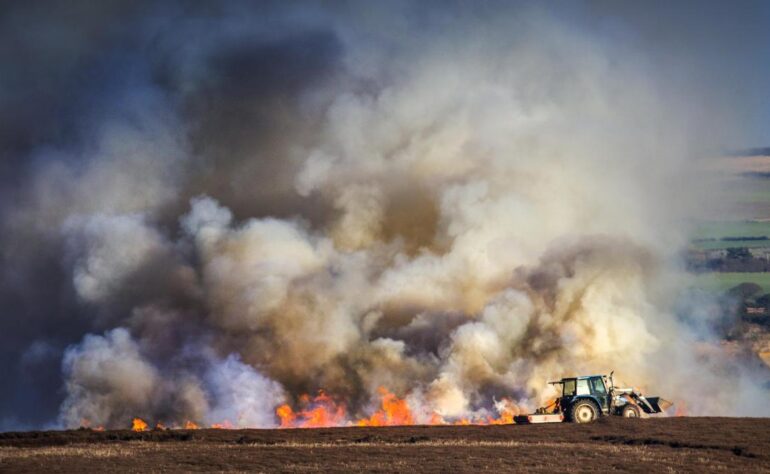Today the burning of Britain’s carbon-rich peat moors by grouse shooting estates begins amid mounting controversy surrounding the contribution the practice makes to climate change.
Wild Moors is warning that a complete ban on burning on peatlands, a ritual performed to provide younger, more nutritious heather to be eaten by grouse reared for shooting, must be implemented to protect one of the nation’s largest carbon stores from being damaged.
The start of this year’s burning season comes as global leaders prepare to flock to Britain for the UN Climate Change Conference (COP26), where restoring land for nature, carbon capture and people is expected to be one of the hot topics on the agenda.
Luke Steele, Executive Director of Wild Moors, said:
“At COP26 Britain has a prime opportunity to be a trailblazer in managing land for nature as a solution to climate change and biodiversity loss. But how can we be a role model for other nations to follow when we still allow our carbon-rich peatlands to be torched to benefit grouse shooting?
“If we are to tackle the climate crisis, we must face the facts: burning moors harms fragile peatland ecosystems, releases climate-altering gasses into the atmosphere, worsens flooding in downstream communities and exacerbates wildfire risk by converting wetlands into highly-flammable tinderboxes.
“It’s past time to put an end to the burning of peatlands for grouse shooting.”
The nation’s peatlands store more carbon than all the forests in the UK, France and Germany combined. But grouse moor burning has become the biggest threat to some of the country’s most important conservation sites. Subsequently, only 4% of England’s upland peat is in favourable condition which is converting these important habitats from carbon stores into carbon emitters.
In recognition of the environmental damage caused by burning the government introduced a partial ban on the practice in May, acknowledging that “burning is damaging to peatland formation” and “makes it more difficult or impossible to restore these habitats to their natural state”.
However, Wild Moors is warning that a significant number of Britain’s grouse moors are exempt from the new rules because they are located on degraded shallow peat, not blanket bog, despite urgently needing to be restored to a healthier, deeper state.
In the North York Moors, one of the largest expanses of heather moorland in the UK, the new rules fail to stop burning on any grouse moors. In the Peak District, a third of grouse moors remain exempt.
The Climate Change Committee, which advises the government on environmental action, has recommended that grouse moor burning is completely banned to protect peatlands from further damage.
Luke Steele adds:
“Given the world is fast moving in a direction where restoring land for nature, carbon capture and people is at the forefront of solving climate change and biodiversity loss, a significant number of the nation’s fragile peat moors are at risk of being left behind if burning is allowed to continue on them.
“With grouse moor burning damaging one of the nation’s largest natural carbon stores, it’s never been so important for the government to introduce an outright ban on this archaic, intensive and environmentally-destructive practice.”
– ENDS –
Notes for editors:
- Wild Moors seeks to unlock an area of uplands the size of Greater London for regeneration by 2030. By working with communities, companies and government, Wild Moors acts as a catalyst for effective and lasting change.
- Research by the University of Leeds and others has found that grouse moor burning degrades peatland habitat, reduces biodiversity and increases flood risk.
- Broadcast quality footage and print quality photographs of burning on grouse moors are available to download here, with full permission granted for re-publication.
